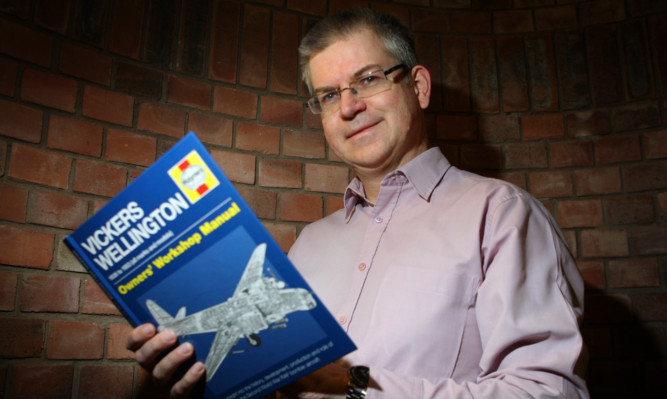A bolt by bolt guide for a famous wartime bomber has been the labour of love of a Dundee University lecturer.
Dr Iain Murray of the university’s school of computing said he is pleased with the success of his owners’ manual for the Vickers Wellington the RAF’s main bomber for half of the Second World War.
The secrets of the aircraft’s construction and other technical details are brought to life in the book. The manual gives some historical background and includes various pilot checks and armament checks.
Everything from the cockpit drill to pre-flight, take-off, landing and gun turret checks are covered. The aircraft is famous for its geodetic framework, which made it both light and able to withstand heavy combat damage.
Dr Murray said: “The structure of the Wellington looked complex, but it was actually very easy to mass produce, as most of the frame components could be made on just one machine.
“This also made it very versatile, and it was used in a range of roles throughout the war, being built in larger numbers than any other British multi-engined aircraft.”
Recently published by Haynes, famous for its range of car repair manuals, the book is the 40th in a new range of manuals covering historic aircraft, ships and other vehicles ranging from the Routemaster bus to the space shuttle.
Dr Murray added a book about the Dam Busters to the range last year, which is being sent for a reprint.
He has also written a history of the work of Sir Barnes Wallis, who designed the Wellington’s structure and the famous bouncing bombs used by the Dam Busters.
Dr Murray is also a member of the Tayside and Fife branch of the British Science Association and researching the history of science has been his hobby for a long time.
On trips to London with the association Dr Murray would always make time to visit the nearby science museum library, where Barnes Wallis left all of his papers before he died.
He said: “Every time I went I found something new and thought ‘There will be a book in this. When I heard Peter Jackson was making a film about the Dam Busters I thought now is the time to do it.
“Now the books are finished, but we are still waiting for the film.”
Dr Murray will be giving a talk on Barnes Wallis in the main lecturer theatre of Abertay University on Thursday at 7pm as part of the association’s public lecture programme.
As well as a copy of the book Dr Murray will also have a flight simulator that will give people the chance to look around some of Barnes Wallis’ post-war planes that were never actually built.
Vickers Wellington: Owner’s Workshop Manual is available from Amazon and most bookshops, priced £22.
More information is available at SirBarnesWallis.com.
